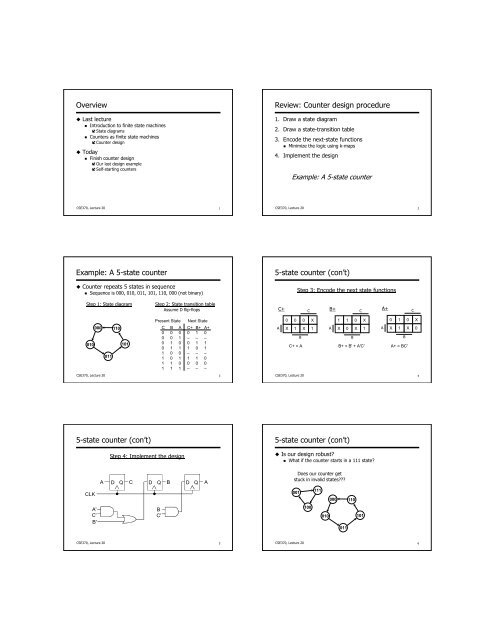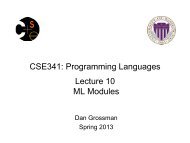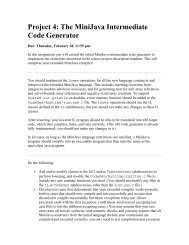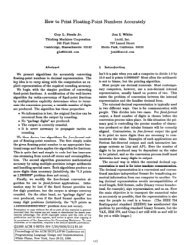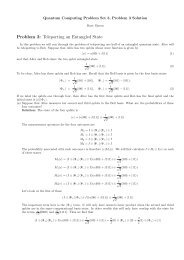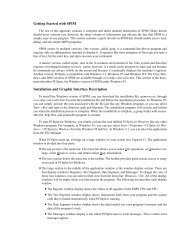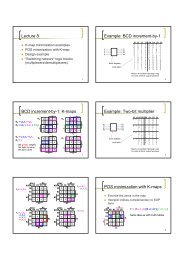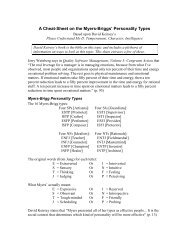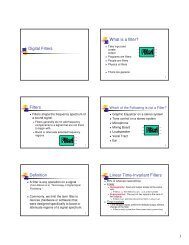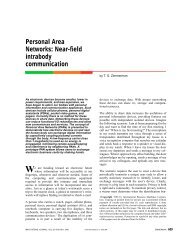Counter design; Self-starting counters
Counter design; Self-starting counters
Counter design; Self-starting counters
Create successful ePaper yourself
Turn your PDF publications into a flip-book with our unique Google optimized e-Paper software.
Overview<br />
Last lecture<br />
Introduction to finite state machines<br />
State diagrams<br />
<strong>Counter</strong>s as finite state machines<br />
<strong>Counter</strong> <strong>design</strong><br />
Today<br />
Finish counter <strong>design</strong><br />
Our last <strong>design</strong> example<br />
<strong>Self</strong>-<strong>starting</strong> <strong>counters</strong><br />
CSE370, Lecture 20<br />
Example: A 5-state counter<br />
<strong>Counter</strong> repeats 5 states in sequence<br />
Sequence is 000, 010, 011, 101, 110, 000 (not binary)<br />
Step 1: State diagram Step 2: State transition table<br />
Assume D flip-flops<br />
010<br />
000<br />
CSE370, Lecture 20<br />
011<br />
110<br />
101<br />
5-state counter (con’t)<br />
CLK<br />
A'<br />
C'<br />
B'<br />
A<br />
CSE370, Lecture 20<br />
Present State Next State<br />
C B A C+ B+ A+<br />
0 0 0 0 1 0<br />
0 0 1 – – –<br />
0 1 0 0 1 1<br />
0 1 1 1 0 1<br />
1 0 0 – – –<br />
1 0 1 1 1 0<br />
1 1 0 0 0 0<br />
1 1 1 – – –<br />
Step 4: Implement the <strong>design</strong><br />
D Q C D Q B D Q A<br />
B<br />
C'<br />
1<br />
3<br />
5<br />
Review: <strong>Counter</strong> <strong>design</strong> procedure<br />
1. Draw a state diagram<br />
2. Draw a state-transition table<br />
3. Encode the next-state functions<br />
Minimize the logic using k-maps<br />
4. Implement the <strong>design</strong><br />
CSE370, Lecture 20<br />
CSE370, Lecture 20<br />
Example: A 5-state counter<br />
5-state counter (con’t)<br />
Step 3: Encode the next state functions<br />
C+ C B+ A+<br />
C<br />
C<br />
A<br />
0 0 0 X<br />
X 1 X 1<br />
B<br />
A<br />
1 1 0 X<br />
X 0 X 1<br />
C+ = A B+ = B' + A'C'<br />
5-state counter (con’t)<br />
Is our <strong>design</strong> robust?<br />
What if the counter starts in a 111 state?<br />
CSE370, Lecture 20<br />
Does our counter get<br />
stuck in invalid states???<br />
001<br />
100<br />
111<br />
010<br />
000<br />
011<br />
B<br />
110<br />
101<br />
A<br />
0 1 0 X<br />
X 1 X 0<br />
B<br />
A+ = BC'<br />
2<br />
4<br />
6
5-state counter (con’t)<br />
Back-annotate our <strong>design</strong> to check it<br />
Fill in state transition table<br />
Present State Next State 001<br />
C B A C+ B+ A+<br />
000 110<br />
0 0 0 0 1 0<br />
0 0 1 1 1 0<br />
0<br />
0<br />
1<br />
1<br />
0<br />
1<br />
0<br />
1<br />
1<br />
0<br />
1<br />
1<br />
010<br />
101<br />
1<br />
1<br />
1<br />
0<br />
0<br />
1<br />
0<br />
1<br />
0<br />
0<br />
1<br />
0<br />
1<br />
1<br />
0<br />
0<br />
0<br />
0<br />
100<br />
011<br />
1 1 1 1 0 0<br />
111<br />
CSE370, Lecture 20<br />
Draw state diagram<br />
The proper methodology is to <strong>design</strong><br />
your counter to be self-<strong>starting</strong><br />
Next subject: Finite-state machines<br />
Generalize the counter-<strong>design</strong> methodology<br />
State machines have input signals<br />
State machines have complex transitions<br />
Finite-state machines control digital systems<br />
The core of digital <strong>design</strong><br />
CSE370, Lecture 20<br />
7<br />
9<br />
<strong>Self</strong>-<strong>starting</strong> <strong>counters</strong><br />
Invalid states should always transition to valid states<br />
Assures startup<br />
Assures bit-error tolerance<br />
Design your <strong>counters</strong> to be self-<strong>starting</strong><br />
Draw all states in the state diagram<br />
Fill in the entire state-transition table<br />
May limit your ability to exploit don't cares<br />
Choose startup transitions that minimize the logic<br />
CSE370, Lecture 20<br />
8


